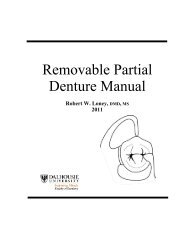Manuals_files/CD Manual 12.pdf - Removable Prosthodontics
Manuals_files/CD Manual 12.pdf - Removable Prosthodontics
Manuals_files/CD Manual 12.pdf - Removable Prosthodontics
Create successful ePaper yourself
Turn your PDF publications into a flip-book with our unique Google optimized e-Paper software.
Maxillo-mandibular Relationships - 34<br />
e. If the OVD is changed, condylar inclination will not have to be readjusted if an arcon<br />
articulator is used (Celenza)<br />
f. CR is not far from CO at same occlusal vertical dimension (Wilson and Nairn)<br />
Reasons's for NOT using CO in edentulous patients<br />
a. CO may be a dysfunctional position (must palpate muscles, TMJ to ensure no<br />
dysfunction) (Brill et al)<br />
b. The actual position is more difficult to determine - studies have shown it is not as<br />
reproducible. Patients cannot tell where centric occlusion or a habitual position<br />
is with bulky wax rims in position. Basically there is no habitual position with new<br />
wax rims (Crum & Loiselle; Brill et al.)<br />
c. Since CO is not reproducible, the influence of other variables on the centric record<br />
cannot be assessed (Yurkstas and Kapur) e.g.:<br />
- Wax consistency<br />
- Biting force<br />
- Symmetry of guidance<br />
d. CO may lead to dysfunction - no studies to absolutely prove this hypothesis<br />
When to use CR<br />
a. When entire occlusion being restored (i.e. no remaining posterior centric stops)<br />
b. When complete, fixed, or removable partial dentures involve the entire occlusion<br />
c. if a nonpathologic natural occlusion exists (posterior centric stops present), and there<br />
is no valid reason to change it, then restorations should be made in maximum<br />
intercuspation<br />
How to obtain CR<br />
The Dawson method (bimanual manipulation) produces reasonably good results:<br />
1. The patient should be placed in a slightly supine, position<br />
2. Place notches in the occlusion rim to aid in stabilizing the record bases with index<br />
fingers on the rim, and thumbs under symphysis<br />
3. Jiggle the lower jaw – the mandible should freely arc<br />
4. Allow the patient to close the last portion<br />
5. DO NOT PUSH THE MANDIBLE or dislodge the record base<br />
6. The registration media must be dead soft , when the patient close into it















